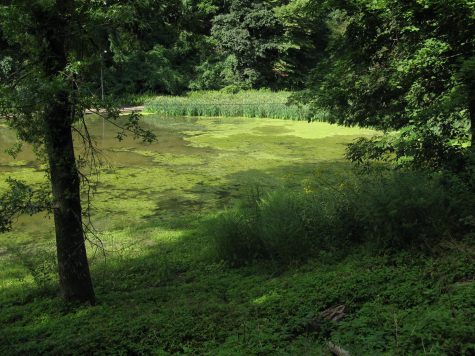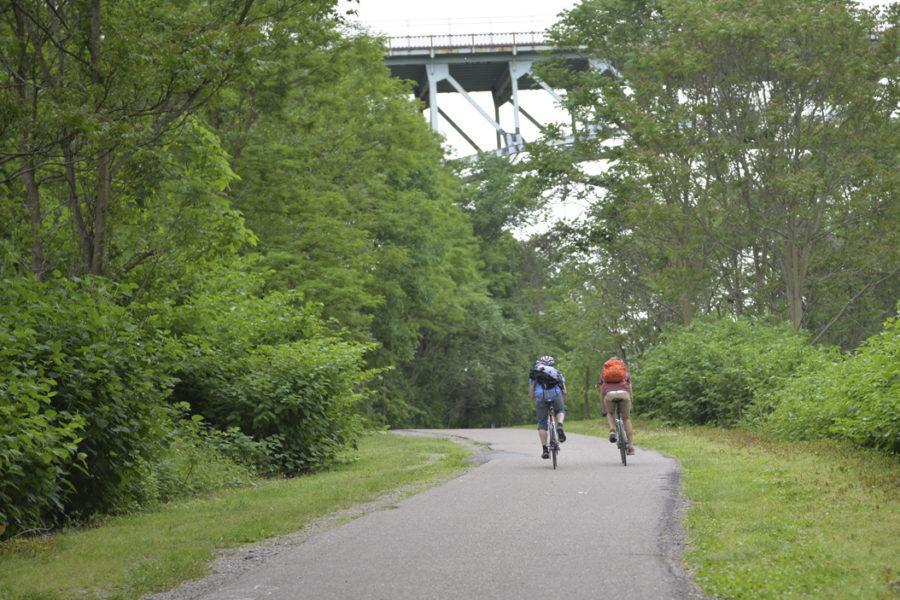Opinion | Prioritize green during the move-in blues
Bikers ride along a path in Schenley Park.
August 25, 2022
Wow, can you believe it’s August already? Time really flies when you’re working, interning, job-searching, soul-searching, vacation-setting and trying-to-survive-amid-perpetual-chaos, doesn’t it?
Well, welcome back to campus in one of the cloudiest cities in the United States. Pitt might be trying to fool students into thinking Pittsburgh has sunshine by the photos they stock their various website pages with, but the unfortunate truth is that Pittsburgh is oh-so-gloomy. However, it’s also true that Pittsburgh has wonderful green spaces around campus that are accessible through a manageable walk, drive or bus ride.
Moving back to the city can be hectic, especially when thousands of other students are making the same tense, stress-inducing move. Amid the move-in blues, make sure to take advantage of the green spaces in our grey city.
Lower Panther Hollow Trail
Panther Hollow is a small, historic neighborhood located in Central Oakland that was home to one of the first Italian neighborhoods in the City. Although most students don’t know about the neighborhood, they surely know the Lower Panther Hollow Trail. Located just over one mile from the Cathedral of Learning, this trail makes for easy hiking as it’s only one mile on relatively flat ground. But if sitting is more your speed, the amoeba-shaped lake is a beautiful spot to hang around, especially at sunset. The lush green surroundings block out the buzz of the city just outside its oasis while the watershed lulls you into relaxation. What could be a better treatment for beginning of the semester stress?
Schenley Park
456 acres of land sit between Oakland and Squirrel Hill, donated in 1889 by Mary Schenley — hence the name, Schenley Park — and have become a staple in outdoor enjoyment for university students and Pittsburgh residents alike. Unless you’re a new student, you’ve definitely walked through parts of Schenley Park. Schenley Plaza, located on Forbes Avenue across from the Cathedral of Learning, is a spot Pitt and CMU students frequent thanks to the lush, inviting lawn and benches surrounded by native plants. Many events are hosted in the park, which is an even more compelling reason to venture outdoors into the sea of green that exists on our campus.
Westinghouse Memorial
If you look at the elevators located in Pitt’s buildings, you’ll notice at the bottom of the threshold that they’re branded with “Westinghouse.” George Westinghouse was a famous engineer and inventor who was not a Pittsburgh native, but did base his work in Pennsylvania. His contributions are seen in our industrial infrastructure, but the beautiful bronze memorial located along the Steve Faloon trail in Schenley Park brings a beautifully maintained natural area that’s teeming with life. By day, dragonflies dart above the lily pads while birds grace the sidewalk, grazing for bugs among the native plants. By night, the frogs that usually take shelter in the pond’s cover scurry out in the open. Whether you’re looking for a quick stroll or somewhere to throw a blanket down and relax, this spot is too good to ignore.

(Clare Sheedy | Assistant Visual Editor )
Frick Park
Frick Park, named after Henry Clay Frick — a native to southwestern Pennsylvania — is a historic park in Pittsburgh’s Squirrel Hill neighborhood. With 17 miles of trails you can walk or bike though, it’s a place worthy to visit. Depending on how deep you venture, you’ll feel as though you’ve escaped the city completely.
Once while hiking the trails, I spotted a black squirrel frolicking around the trees — a rare sight. If that’s not enough to convince you to explore the 644 acres of Pittsburgh’s largest historic regional park, I don’t know what is. But if you need that extra push, it’s also home to Blue Slide Park. You know, the focus of Mac Miller’s album, “Blue Slide Park.”
Three Rivers Heritage Trail
Pittsburgh’s bridges are famous considering the stunning number of them — a whopping 446. But the reason we have so many bridges is because of the natural landscape and features that make the region so special. Pittsburgh’s three rivers — the Monogahela, Ohio and Allegheny — are iconic features of the City and act as the main attraction for the Three Rivers Heritage Trail. Spanning over 33 miles, the trail offers intimate views of the City on either side of all three rivers, and is a must see feature to return to over and over again while in Pittsburgh.
Wherever you are in Oakland, on or off campus, prioritizing enjoying the green spaces available to you is a must. With the immense benefits — including improving your mental health and creating safer communities — that natural spaces can provide, you owe it to yourself and to the hard work that Pittsburgh Parks Conservancy and Friends of the Riverfront put into maintaining these beautiful spaces to visit as often as possible.
Grace DeLallo writes about social, environmental and political issues. Write to her at gkd5@pitt.edu.




